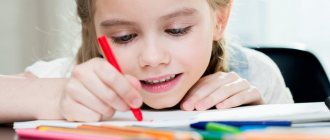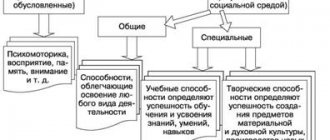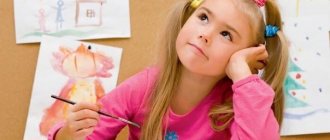Setting up a creative corner
We found the source - we create the conditions. The problem of a carpet stained with plasticine and painted wallpaper will be solved by a specially equipped creative corner. Let your child take a break from the outside world and immerse himself in his favorite hobby, without fear of being punished for making a mess or ruining things.
A place for children's creativity may resemble the aftermath of a hurricane, but you should be able to close your eyes to this. “No chaos - no inspiration. “It’s like a kitchen during lunch,” said American philologist and writer Mason Cooley.
Embrace clutter as part of creativity.
Creating conditions and atmosphere is important. Even more important is to develop the desire to create and find sources of inspiration.
The role of the family in the development of creative abilities of preschool children
Who, if not the parents, is obliged to notice what the child is more drawn to, what his capabilities are in a particular period, and on the development of what abilities it is important to focus the main attention.
Of course, a preschooler’s personality should be enriched in different directions - teaching drawing and modeling, designing and inventing stories together, organizing a simple home theater. In each of these types of activities there is room for the transformation of reality and the manifestation of creative abilities.
Most children do not have a special interest in all types of activities, but highlight priority ones for themselves. It is in this field that parents should create conditions so that the child discovers new means and expands the options for using them to realize his plans. Directed efforts of loving and understanding adults, unobtrusive participation in children's games and activities can and should be used to develop the creative abilities of preschoolers.
We fantasize every day
Do you want to discover and develop your creative potential? It would be good to include creative activities in your schedule, like meals, walks, sports and other activities. It is important not to overdo it, not to turn creativity into a boring obligation. After all, for a child this is first and foremost a game.
Adding creativity to everyday chores
Even cleaning your room or cooking can be fun if you add creativity and imagination to it. Compete to see which of you can clean the room better and receive a prize as the top cleanest person. Prepare a delicious dinner according to the secret recipe of a famous French chef, and wash the dishes on behalf of the spirit of purity. You need to show your child that even a seemingly boring activity can be exciting and fun. With this approach, you yourself will cope with the routine faster.
Are some things lost? Why not turn their search into a quest!
Exercise “Find a Use”
Think together about how to use household items in a non-standard way. For example, you can use a toothbrush to brush your cat, tickle your friends, draw with paints, etc.
“Prerequisites for the development of a creative personality”
“Prerequisites for the development of a creative personality”
Executor:
Samoilova E.V.
Krasnokamensk 2021
Content
Introduction………………………………………………………………………………..2
- Creative person. Development and formation of creative
personality. Character traits and features of the path of a creative personality……4
2. Development of creative abilities in children………………………………….8
3. Technology and conditions for the development of the creative potential of the individual……..10
4. Development of the creative personality of students in conditions
developmental education. Requirements for a teacher……………………….11
Conclusion……………………………………………………………………………….13
References……………………………………………………………15
Introduction
Nowadays, when there are about 30 children per teacher in children's groups, it is not always possible to create conditions for the development of a creative personality in a person. The creative process requires a certain freedom, time, means and an individual approach. In the time frame and conditions in which children's groups find themselves in many kindergartens and schools, it is not always possible to fully unleash the child's creative potential. In this case, additional education provides good opportunities, but also in the ordinary pedagogical process, when certain conditions are created, the formation of a creative personality occurs. The personality of the teacher is of decisive importance in this matter.
The purpose of my work is to determine the prerequisites for the development of a creative personality. In order to find out what these prerequisites are, it is necessary to find a definition of what a creative personality is, what distinctive qualities it has, what conditions must be created for its development, what qualities a teacher should have.
Is creativity a personality trait we are born with, or a skill that can be developed? Geneticists who study this issue say we are all born with creativity—the ability to solve problems by combining complex and sometimes unrelated ideas.
I have never met a child attending a regular kindergarten who is devoid of creative inclinations. The solutions that children come up with in response to creative tasks are very diverse - it depends on the child’s temperament and level of development, his abilities, skills and personal experience.
Creativity is so important in our lives that every effort must be made to reveal the creative potential of the child and to arouse in him the desire for creative activity.
1. Creative personality. Development and formation of a creative personality. Character traits and features of the path of a creative personality
A creative person is a person who finds non-standard solutions to the problems facing him.
Each of us is gifted with the ability to solve problems, but people who use creativity to solve problems have certain personality traits. Firstly, they absorb the experiences of others like a sponge. They have an enormous personal store of things they have read, seen or heard, places they have visited or worked, and people they know. The study found that creative people strive for independence, self-sufficiency, self-discipline, perseverance, self-affirmation, and are highly tolerant of uncertainty. They take risks and are guided by inner impulse. They don't care about standards and opinions, and they have little interest in interpersonal relationships. Creative people usually have an innate skepticism and a very sharp mind. They are active, observant and executive, drawing conclusions using intuition rather than logic. They have an ease that allows them to find new associations. In general, creative people perform difficult tasks as if they were nothing difficult, and are unhappy and depressed when they fail to create. (https://www.psyhodic.ru/arc.php?page=3636)
The search for qualities characteristic of a creative personality was carried out by the author of works on the theory of development of a creative personality G.S. Altshuller through traditional procedures - collection of information and its analysis. Biographies of a significant number of scientists, engineers, and public figures who made the most noticeable positive contribution to the development of our civilization were collected. As a result, a list of requirements was determined for a person who strives to ensure that his life does not go in vain and does not turn out to be fruitless. There were six of these qualities - requirements.
Having a worthy goal. It is the goal, the task that defines a person. The goal must be new or unachieved. Either the means to achieve the goal must be new. The goal must be socially useful, positive, aimed at the development of life. The goal should be specific and achievable: not general good intentions, but a clearly defined task. The chosen goal can be called the equivalent of your own life. A worthy goal is a personal goal of an individual or a small team or group of associates.
Requirement number two is the presence of a set of real work plans to achieve the goal. Striving for a goal without a plan is a chaotic pursuit. The presence of a worthy goal, set at the limit of a person’s capabilities and strength, certainly requires the mobilization of all his resources, all his time and effort. After all, an adult is forced to distribute his time between achieving a goal, regular work, family, raising children, caring for parents...
The third quality - requirement - is high efficiency in fulfilling the plans. Ensuring such performance over a long period of time is in itself a difficult task for most people. A huge number of obstacles and temptations stand in the way of fulfilling your plans.
The fourth necessary requirement is a good technique for solving problems. Even the presence of large reserves of time does not guarantee the solution of a problem without a technique for solving special problems, without mastered techniques of mastery. A writer or poet must know the grammar of the language in which he writes, know it perfectly. Otherwise, it will not be easy to select the required language constructs. The situation is similar with an engineer designing a complex device. The arsenal must have all the possibilities, all the achievements of engineering science, otherwise the design may turn out to be obsolete even before its birth.
The fifth quality is the ability to “take a hit.” The trials of the person who proposes something new do not end when a new solution, a new principle, is found. The ability to “take a punch” is the ability to resist the opinions of authorities, inertia and the habit of the majority of people to the familiar, established. The new is scary and requires specialists to retrain. However, the ability to “take a hit” will be required not only in a situation of struggle for something new. Difficulties are not all water and fire. People have long understood that one of the greatest obstacles to human growth is “copper pipes” - for example, the fact of recognition of an innovation or development. It is the fact of recognition of merit that very often leads to a halt in development. And therefore the last, sixth requirement - effectiveness - seems important. Achieving a previously set goal should not lead to a stop in work. Each solved problem should open up new horizons. “For creative tactics, the main thing is to ignite the fire of an idea. For a creative strategy, the main thing is to carry fire through your entire life.”
(Klyaus E.M. Searches and discoveries M. Nauka 1986 P.98.)
After the “switching on” of the creative program occurred, interest in research and one’s own fruitful creative work appeared; self-education became the most important element of development. The individual must accumulate a huge amount of knowledge necessary for effective subsequent activities.
“Jules Verne used a lot of data for his novels. Therefore, he “prepared materials for future use.” While reading books, magazines, newspapers, the novelist made notes on physics, chemistry, astronomy, geography, geology, history, etc. By the end of his life, more than twenty thousand bundles with extracts had accumulated...” (Riss O.V. From idea to book. M.: Book, 1969. P.27.)
There are many examples of such long-term ascetic labor. V. Harvey worked for thirteen years on a small book about blood circulation; N. Copernicus created his treatise over thirty years. It should be noted here that a person is forced to fight not only against external circumstances, but against internal ones, with his own laziness and carelessness. This struggle is invisible, but sometimes no less cruel than the struggle with external circumstances.
The difficulties of everyday life have led many talented people away from research. Not everyone can find the opportunity to work on what they love, combining it with work, everyday life, and family. And yet people pass this test too. A creative person draws all resources from himself, from his environment, turning everything that is available into elements of his design.
(Malakhov A.A. Accumulation of information M.: Nauka, 1984. P24,28.)
Of course, maintaining such a daily routine requires courage. Over the course of many years, there has been a persistent and quiet rejection of goods and earthly joys, which for many constitute the limit of desire. Working on what you love becomes a blessing and a joy.
“My only desire is to work without thinking about expenses... I don’t need the usual pleasures of the rich. I don’t need horses or yachts; I don’t have time for all this. I need a workshop! So said Edison (American inventor and entrepreneur, creator of the phonograph)
“The scientist needs a less showy, but more enduring kind of courage to choose an activity that is sure to deprive him of many joys... A young person who wants to enter science must be capable of revaluing values and rejecting conventional symbols of success. This requires extraordinary courage and faith.”
(Selye G. From dream to discovery. M.: Progress, 1987. P.57.)
- Development of creative abilities in children
“A child who has experienced the joy of creativity, even to the smallest extent, becomes different from a child who imitates the acts of others.”
B. Asafiev
Outstanding teachers of the 20s and 30s invested a lot of talent, intelligence and energy in the development of pedagogical problems related to the creative development of the individual, primarily the personality of the child and teenager: A.V. Lunacharsky, P.P. Blonsky, S. T. Shatsky, B. L. Yavorsky, B. V. Asafiev, N. Ya. Bryusova. Based on their experience, enriched by half a century of development of the science of teaching and raising children, the best teachers continued and continue to theoretically and practically develop the principle of creative development of children and youth.
Creativity gives birth to a living fantasy and a vivid imagination in a child. The creative principle in a person is always a striving forward, for the better, for progress, for perfection and, of course, for beauty in the highest and broadest sense of this concept. This is the kind of creativity that art cultivates in a person, and in this function it cannot be replaced by anything. In its amazing ability to evoke creative imagination in a person, it undoubtedly occupies first place among all the diverse elements that make up the complex system of human upbringing.
It is imperative to support any desire for creativity in a child, no matter how naive and imperfect the results of these aspirations may be. The child may not become an artist, a musician, or a poet (although at an early age this is very difficult to foresee), but perhaps he will become an excellent mathematician, doctor, teacher or worker, and then the most beneficial ways will make themselves felt. his childhood creative hobbies.
A conversation about nurturing creativity in a person leads us to a very important problem: the difference between a specialist creator and a specialist craftsman. A true specialist-creator differs from an ordinary specialist-craftsman in that he strives to create something beyond what he is supposed to create “according to the instructions.” The craftsman is satisfied with creating only what he is supposed to. This generally formal attitude towards one’s work, no matter what area it may be, does not move life forward and serves as a brake. The presence or absence of a creative attitude in a person towards his work becomes the dividing line that passes between the specialist-creator and the specialist-craftsman.
The formation of a person’s personality occurs throughout his life. Children and adolescence are especially important in this regard.
The formation of personality is influenced by upbringing, social environment and hereditary inclinations. But the inclinations themselves do not provide abilities and high performance results. Only in the process of upbringing and training, social life and activity, and the acquisition of knowledge and skills, creative abilities are formed in a person on the basis of inclinations. The inclinations can be realized only through human interaction with the surrounding social and natural environment.
The teacher’s task is to contribute to this formation as much as possible.
Creativity presupposes that an individual has abilities, motives, knowledge and skills, thanks to which a product is created that is distinguished by novelty, originality, and uniqueness. The study of these personality traits has revealed the important role of imagination, intuition, unconscious components of mental activity, as well as the individual’s need for self-actualization, in revealing and expanding one’s creative capabilities.
Only independent creativity of children in class will awaken their dormant abilities. The main driving force of creative activity is motive. This could be an educational interest, a desire to please a loved one, or to express one’s feelings and thoughts. After the goal is formed, the child should be given a choice of means, since creativity presupposes freedom of choice. The help of an adult should be advisory in nature. At the end of the lesson, you need to find something to praise the child for.
- Technology and conditions for the development of individual creative potential
The structure of the technology for developing the creative potential of an individual includes the following main components:
1. Preliminary diagnosis of the level of creative development;
2. Motivation (represents one of the leading areas of work);
3. Organization of creative activities. Certain conditions must be created to promote the development of the creative potential of the individual and its realization.
4. Quality control of creative activities.
5. Determining whether the results obtained correspond to those planned. Objective and reflective analyzes of the effectiveness of the work performed. Identifying difficulties and problems in solving problems and making the necessary adjustments.
For the realization and development of a subject in creative activity and, in particular, for the development of his creative potential, freedom is a necessary condition. It is not without reason that psychologists, in order to stimulate the development of creative potential in children, recommend games with simple objects to give the child the opportunity to “think through” and “finish the idea.” Highlighting freedom as an indispensable condition for all creativity, Lev Vygotsky noted that “children’s creative activities can be neither obligatory nor forced and can only arise from children’s interests.”
A necessary condition for the development of creative potential is a developed emotional sphere of the individual. In creative activity, two directions of emotional experience can be distinguished:
— emotional experience of a creative object;
- emotional experience of the process of activity itself.
Emotions are a reflection of a person’s attitude to the world around him, to people, to the activity being performed, therefore, one of the conditions for the success of creative activity should be considered emotional experience. For the successful development of an individual’s creative potential, it is necessary to expand his experience (emotional, intellectual, social, etc.).
(I.T. Kavetsky, T.L. Ryzhkovskaya, I.A. Koverzneva, V.G. Ignatovich, N.A. Loban, S.V. Starovoitova. Fundamentals of psychology and pedagogy - Minsk: MIU Publishing House, 2010)
4. Development of the creative personality of students
in the conditions of developmental education. Requirements for a teacher
Research by psychologists and didactics has established, and school practice has confirmed, that the formation and development of the creative personality of students depends on the creative abilities of the teacher. From the above it follows that teaching creativity should be carried out by highly qualified specialists, creatively active teachers, distinguished by the presence of a dominant need for creativity in their scientific, educational and educational activities.
The ability to see and identify the individually unique characteristics of a particular person is of decisive importance for a teacher.
The teacher's personal concept should consist of:
— searching for creative methods of forming and improving basic knowledge, skills and abilities and variable use in lessons;
— creating conditions for the development of children’s potential in an atmosphere of creativity, understanding, and support;
— activation and improvement of the basic mental mechanisms underlying the creative development of primary schoolchildren (memory, attention, thinking, imagination);
— expanding the boundaries of knowledge of younger schoolchildren through the use of creative teaching methods and techniques.
With the individualization of learning, such qualities as independence, initiative or an exploratory style of activity, creativity and others receive particular importance and development. Individualization of learning contributes to the development of students' abilities; their inclinations and interests, different attitudes to learning and to individual academic subjects are taken into account. One of the means of accomplishing this task is to use tasks in independent work that are identical in content, but different in the method of completion...
The “launching pad” for successful learning and the formation of a creative personality is the presence of three components of intellectual activity aimed at mastering something fundamentally new:
1) a high level of formulation of elementary cognitive processes;
2) high level of active thinking;
3) a high level of organization and purposefulness of cognitive processes.
This can be achieved using an internal action plan: planning, analysis, reflection.
A teacher or educator must guide the child’s development in the following areas:
a) the child learns, perceives and assimilates the environment;
b) the child influences the environment;
c) the child acquires the ability for orientation and self-regulation, he develops a personal approach to phenomena, the environment, behavior, and knowledge becomes practically directed. The active introduction into the traditional educational process of various developmental activities and systems of creative tasks, specifically aimed at the development of creative activity, the personal-motivational and analytical-syntactic spheres of the child, memory, attention, imagination and a number of other important mental functions, is in this regard one of the most important tasks of the modern teacher in the development of the child’s creative potential.
(https://infourok.ru/)
Conclusion
Based on the above, we can formulate the following prerequisites for the development of a creative personality (these are requirements for the teacher and the environment):
1. The presence of developed creative activity in the teacher, a developed moral principle, since the teacher must cultivate in the child the need for creativity, which is impossible without the presence of a creative goal.
2. The teacher must be a kind, sympathetic, interesting person in order to enrich the child’s emotional sphere through interaction.
3. The teacher must know his subject well, problem-solving techniques, he must be a master of his craft in order to help the child complete specific tasks, suggest ideas in case of difficulty, and equip the child with knowledge and skills.
4. The teacher must support the child’s ability to work within the time allotted for a given age - encourage, create a positive emotional mood, support in case of failure, not give impossible tasks, encourage creative activity.
5. The teacher must cultivate in the child the ability not to give up, to overcome difficulties, laziness that may arise at a certain stage of work, to instill hard work, attentiveness and accuracy. The ability to work in a team will also be useful; it is necessary to provide children with the opportunity to perform collective work.
6. The teacher and other participants in the educational process (administration of the institution, parents) must take care of creating a comfortable and conducive atmosphere for creativity, a sufficient number of aids and materials for creativity, so that the child is given freedom of choice in activities, and the best experience of human culture is clearly conveyed.
7. High-quality, age-appropriate and slightly advanced materials for self-education should be available; the teacher should encourage the child’s aspirations to learn something new, to learn something beyond the program.
8. A teacher must know the basics of pedagogy and psychology, be an attentive and sensitive person, have the opportunity to work individually with children, and help each child reach their potential.
One of the main prerequisites for the development of a creative personality is the formed need for creativity. The teacher needs to “ignite” the child’s heart, captivate him with creative activity so that it is a priority when choosing leisure time, because a creative person is a person happy in his activity, productive and positive, capable of bringing joy to himself and others.
Bibliography:
1. Altshuller G.S. “Find an idea: Introduction to TRIZ - the theory of solving inventive problems” Ed. "Alpina Publisher", 2014
2. Veraksa, N. E. Child psychology: textbook / N. E. Veraksa, A. N. Veraksa. – Moscow: Yurayt, 2014. – 445 p.
3. Gurevich, P. S. Psychology and pedagogy: textbook / P. S. Gurevich. – Moscow: Yurayt, 2014. – 478 p.
4. Kavetsky I.T., T.L. Ryzhkovskaya, I.A. Koverzneva, V.G. Ignatovich, N.A. Loban, S.V. Starovoitova. “Fundamentals of psychology and pedagogy” - Minsk: MIU Publishing House, 2010)
5. Klyaus E.M. Searches and discoveries M. “Science”, 1986
Kotova, I.B. General psychology: Textbook / I.B. Kotova, O.S. Kanarkevich. - M.: Dashkov and K, Academcenter, 2021. - 480 p.
6. Malakhov A.A. “Accumulation of information” M.: “Nauka”, 1984.
7. Riess O. V. “From idea to book.” M.: “Book”, 1969.
8. Selye G. “From Dream to Discovery.” M.: “Progress”, 1987.
15
Learning to develop imagination by observing the world around us
Take a walk in the park, get out of town, teach your child to admire the beauty of the world around him. It’s interesting to come up with images while looking at clouds, or to guess objects by their outlines late in the evening. If you take a magnifying glass or binoculars with you, observing birds and insects will be even more interesting.
Artist Rob Sayaj Jr. uses a tablet to create these cloud paintings.
Arm yourself with a whiteboard marker (it washes off easily) and try to draw your own shapes on the glass with your child.
When to start creating?
In this regard, it’s never too early. As soon as you yourself are ready to conduct such activities with your baby. Usually, when a child approaches the first creative skills more meaningfully, this is the period after a year. Here we introduce the baby to new materials, do the first simple manipulations, then improve our skills and come up with new storylines.
Fantasy and imagination develops. Sometimes too much, but don't block your child's little ideas. Pretend that you believe in his miracles. After all, fantasy is a gift that is given to young children to generate creative potential in the future.
But if you want to immerse your child in the creative world, you must be present in it yourself, at least at first. In the future, if the child likes to make something or draw something, he will be carried away by his action and may not notice your absence or even ask you not to interfere, everything is individual here.
But first you must interest the child and sincerely begin to create with him, infect him, so to speak, with your enthusiasm.
Creativity is accessible to everyone
To learn to think creatively, you need to practice. Not everything works out right away, but that’s not a problem: there are no those who have become masters of their craft without any effort.
The good thing about creativity is that it can be inexpensive or even free. Using pebbles, you can turn a milk carton into a musical instrument, make a flower out of a napkin, or make a box out of popsicle sticks. It would be a fantasy!
Simple materials give the child a lot of room for creativity.
Creative abilities of preschool children
Creative abilities, like intellectual ones, belong to the group of cognitive abilities. Only the main load falls on various cognitive processes. In intellectual cognition, thinking plays a leading role, and in creative cognition, imagination plays a leading role. Therefore, the creative abilities of preschoolers begin to develop later - in the second half of preschool childhood.
A child can try on pyramid rings to fit them to size as early as two years of age. This indicates his intellectual development. But a preschooler will be able to see a new image in the same pyramid, calling it “girl”, “slide”, etc., when he receives numerous ideas about the world, comprehends analogies and activates his imagination.
The creative abilities of preschool children are an original approach to understanding the environment, a tendency to find non-standard ways and means of solving problems, and a desire to obtain original results.
Children can realize their creative potential in any type of activity. By drawing or constructing a structure, performing actions with toys, or being carried away by role-playing games, preschoolers are guided by their plan. Since the plan is formed on the basis of how the child perceives the surrounding reality, it can reflect a typical picture, but it can also be very unusual.
Directions for the development of children's creative abilities
Creativity rarely develops on its own. Their development needs stimulation. For this reason, it is important to know in what directions the creative abilities of preschoolers can be developed. There are two effective lines:
- Complicating actions in using means to implement plans
- Expanding the set of tools to solve a specific problem
As an example, consider how children use a bucket. In addition to its direct purpose, it can serve as a form for Easter cakes, the upper part of a constructed tower, a headdress, a chair, a support for a bridge, etc. But children come to this variability with the development of creativity.
The same goes for finding new means to realize your ideas. You cannot draw an outline - a preschooler will lay it out with sticks; no sticks - will line up cubes around the perimeter; there are no cubes - he will stretch out a jump rope or a strap... If there are no more or less suitable means, the older preschooler will act in imaginary circumstances.
Every time the search for suitable means and possibilities for their use is a kind of brainstorming for the creative thinking of a preschooler. Experience confirms that the most original ideas come AFTER trying more familiar options. It is important for adults to remember this fact and encourage the child’s activity in generating new ideas.
We save the results and the desire to create
Children are upset when they find out that their crafts and drawings are thrown away. Therefore, collect and store children's creativity. These are mementos for you and a source of inspiration for your child. And in 15-20 years, yesterday’s scribbles can also mature and grow into professional art.
Children's drawings by artists in a new version. Work by Katherine Brannock
You cannot criticize (,) (,) praise
The child wanted to draw a horse, but a dog came out? Has a pencil drawing turned into a daub after watercolor? The opinion of mom and dad is the most authoritative for the child. A word can inspire or discourage the desire to engage in creativity. Try to respond carefully to the first creative steps.
The courage to criticize must be followed by the courage to praise. Honore de Balzac
Let's dive into art
Introduce your child to literary and musical classics, instill a love of reading books. Instead of toys or goodies, you can buy tickets to the theater, cinema or art exhibition. A change of scenery, going to an unfamiliar place will bring new emotions, joy and inspiration. Art in its purest form is a good teacher, capable of awakening in a child the desire to create his own masterpieces.
Exercise "What if..."
Take a fairy tale as a basis and change one detail in the plot (for example, Little Red Riding Hood did not tell the wolf where her grandmother’s house was). Imagine how the plot of the fairy tale would develop further.
A good book will keep children company and teach them to dream.
What promotes creativity?
Tolerance for the outside world and inner peace are the basis of the creative process. It is easier for a person open to the world, devoid of stereotypes and prejudices, to sense the subtlest matter of creativity, to feel the light breath of the muse behind his back:
- It's worth finding a melody that has a positive impact on the creative process.
- Writing by hand rather than using a computer promotes creativity.
- Meditation is the best way to relax and put your thoughts in order.
- Free association activities will awaken your imagination.
- You shouldn’t get hung up on it, sometimes you should think about something far away. For example, about how to celebrate the New Year in 2030.
- Blue and green colors influence creativity.
- A change of environment can promote creativity.
- Laugh, even through force. This will have a positive effect on the brain.
- Do something with your hands.
- Practice. During sports, not only does the body become stronger, but the brain is also significantly relaxed.
- Try something new. Life and creativity are closely connected, new emotions can be brought, for example, by traveling abroad, conquering mountains, diving to the depths of the sea.
- Sleep, that “morning is wiser than evening” really works.
The process is more important than the result
It is not necessary to strive to raise an artistic genius. It is much more important to see the benefits of creative, extraordinary thinking, which helps solve even the most difficult life situations.
The task of a parent is to awaken in the child a craving for creativity, to help him find his talents and realize them.
Teach to see new opportunities and find innovative solutions.
Creative abilities will serve your child well in school, in work and in life. Invent and create something new. Get the joy of creativity and development with your child!
Creativity and Creativity
Often, most people perceive these concepts as one whole. But such a comparison is wrong. The word “creativity” came to the business community in the late 80s, and only then began to be used in wide circles. Creativity is the ability that a person can demonstrate in non-standard, creative thinking, his ability to put forward unique ideas. Creativity implies the activity of creating, the ability to overcome stereotypes, it is the motivation for something new. Creativity and creativity are closely related, they are increasingly difficult to separate from each other.








